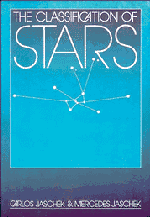12 - G-type stars
Published online by Cambridge University Press: 04 April 2011
Summary
Normal stars
G-type stars are characterized by weak hydrogen lines which become comparable in strength to the lines of some metals. Metallic lines increase both in number and in intensity toward later spectral subdivisions, and molecular bands of CH and CN become easily visible features.
In order to fix ideas, we quote in table 12.1 the equivalent widths of some strong lines.
We have not given the intensity of the G-band, which is easily observable at classification dispersion, but which breaks down on the low plate factor spectrograms needed to measure equivalent widths.
The spectral type is established by the comparison of hydrogen and metal lines, like Fe λ4143 and Hδ: they are about equally intense at G8 when seen at 80 Å/mm. Instead of this pair of lines, Fe λ4045/H λ4101 or Fe λ4384/H λ4340 and λ4921/H λ4861 may also be used. For types later than G5 the Ca i λ4226 line becomes sensitive to temperature and can be used for determination of spectral type as Ca i λ4226/H λ4101 (see figure 12.1).
If it is suspected that there are composition anomalies, the hydrogen-to-metal ratio should not be used but should be replaced by Cr λ4254/Fe λ4250 and Cr λ4274/Fe/ λ4271 (Keenan and McNeil 1976).
If for instance the star has weak metal lines, the ratio between hydrogen and metallic lines is earlier than it should really be, and only the ratio of two metal features can provide the right spectral type.
- Type
- Chapter
- Information
- The Classification of Stars , pp. 275 - 315Publisher: Cambridge University PressPrint publication year: 1987

